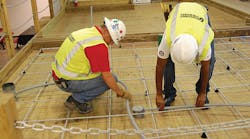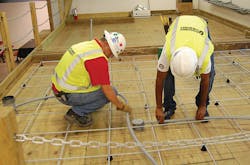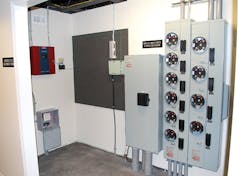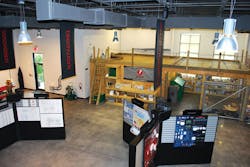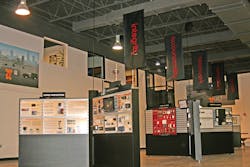During the recession, many construction projects were stalled or canceled, leading to an exodus of workers from the industry. Now that the economy has improved and a recovery is kicking in gear, skilled workers are in high demand.
“When we were in the recession, there was no shortage of folks because there was not a lot of work being done,” says Mitch Permuy, CEO of Power Design, Inc., a Florida-based electrical contracting company. “Now that we are all getting busier again, we are feeling the pinch. Many of our experienced folks are retiring, and those that may have been interested in the construction industry went in other directions.”
Compounding the problem is the fact that fewer young people are pursuing careers in the trades. As a result, electrical contracting companies nationwide are experiencing a significant shortage of not only electricians, but also experienced field supervisors. While certain states are more affected than others by the shortage of skilled labor, field managers are in demand everywhere, and it takes time to train them and gain the experience required, Permuy says.
“The experience isn’t achieved overnight,” he says. “A significant amount of training takes place during the four years that it takes to become a journeyman electrician. Then it takes 15 to 20 years to produce a competent project manager or superintendent.”
Power Design is finding a way to address this challenge head on by cultivating the next generation of supervision with the help of its 12,000-square-foot training center.
“There is a growing need for qualified electricians, and Power Design is recruiting them and introducing them to best practices,” says Terry Elton, who has worked as a superintendent at the company for the last eight-and-a-half years.
Screening leadership candidates
Due to the labor shortage, construction companies nationwide could be promoting or hiring project managers that might not have the experience or the knowledge to be able to handle that level of responsibility, which can lead to many problems, says Stephanie Morge, field training specialist for Power Design.
“There are a ton of issues,” Morge says. “If someone comes onboard and doesn’t know a company’s way of doing things, it can cause a domino effect that affects not only the other field and operational personnel, but also customer satisfaction.”
To prevent this from happening, the company constructed its training center six years ago at its headquarters. At this facility, the electrical contractor evaluates potential hires and prospective managers as well as provides continuing education to seasoned foremen and superintendents. Morge says the training center helps ensure all field employees are well trained before they even step onto a job site.
“It gives them a foundation of what we’re looking for as a company so we can mold them into quality employees,” Morge says.
External job applicants seeking employment as a field superintendent or foreman at Power Design must first pass an evaluation at the training center before being hired. Because the construction industry is such a hands-on, skills-based occupation, it often takes more than a resume review or interview to determine if an applicant is suitable for a certain position.
“In some cases, you may think that a person’s resume looks good, and that they seem pleasant, determined, and professional, but you won’t know how they work unless you evaluate their skills,” Permuy says.
After applicants have passed the interview and resume screening, the company then invites them to the training center for an evaluation. Each applicant must demonstrate his or her skills within the mock example of the scope that they are considered for. If they don’t pass the test, they won’t get the job, Permuy says.
“We evaluate their test results to see if they have the experience they claim,” Permuy says. “This often works out better than someone showing up in the field and having the superintendents evaluate them. The training evaluator determines whether or not they are qualified through a consistent, fair process. While they may fool me in an interview, they won’t fool the evaluator.”
Evaluating future leaders
Power Design not only puts external applicants to the test, but also identifies, cultivates, and evaluates electricians looking to move into leadership positions like foreman or field superintendent. The prospective leaders must earn their journeyman license and obtain 10 hours of training from the Occupational Safety and Health Administration (OSHA) before being considered for advancement.
“Once they become a journeyman and have displayed the required skills, the training at the center kicks in,” Permuy says. “We keep them on the path and talk about the next steps for advancement. We are moving forward all the time, and trying to get them to the foreman level.”
Once the company identifies a potential foreman, it brings them into the training center for an evaluation. Through this exercise, the evaluator can make sure that the potential leadership candidate has the Code knowledge and skills to supervise other electricians.
The trainer places the candidates into a situational example of what they may face in the field, and they are evaluated on how they handle the various assignments presented to them.
“We have an evaluation section for every scope and aspect of a building that we would touch,” Morge says.
After the electricians are evaluated on a particular skill, the trainer then walks them through any areas of concern. They also learn how to become successful managers and leaders, which they may not learn during their apprenticeship. While many trade professionals excel at working individually on an installation, they may struggle when they suddenly have a crew to run, they have to lay out the work, check others’ craftsmanship, and ensure quality control on a job site, Permuy explains.
To help aspiring managers be more successful, the company has a quality control (QC) department, which is housed within the training center. The QC specialists travel to every project to evaluate it at each stage of construction and perform a very detailed in-field inspection.
“They are there to reinforce the training that they got in the training center,” Permuy says. “We try to bring awareness about the importance of overseeing the quality of the work. If some of the managers are new to their position, they may not realize the long-term effect of poor workmanship.”
Elton, who joined Power Design after working for another contractor specializing in hospital work, says he wishes that the training center was already built when he was hired on. He says that it would have given him a smoother transition when moving into his role managing large multi-family residential and mixed-use projects. For those new managers, however, Elton says the evaluations give the company the chance to evaluate the aspiring managers’ skill set compared to the responsibilities and duties of the job they wish to move into.
“It gives you an idea of the parts that they are stronger in, and the parts they need to work on,” he says. “Then when you ask them to do a certain job, you will feel comfortable that they have the skills because they have been evaluated.”
Training managers on best practices
Another way Power Design trains its workers is through its best practices program. Three years ago, the company documented the preferred methods for installations and set up a website with English and Spanish language guides.
The company identified 12 different areas that cover a range of topics pertinent to everyone — from the office and field employees to the operational managers. For example, the best practice guides cover such topics as low-voltage systems, fire alarm systems, temporary power systems, and rough-in and trim out work.
The guides go into detail on every aspect of how the electricians do the install down to what materials they need to perform that particular task in the field. Permuy says the Web-based program walks the employees through how to properly lay out work. It includes photos of well done and poorly performed installations for reference as well as links to the NEC so they can verify that their installation is done correctly.
The site also includes links to training videos and detailed pictures that a manager can print out for its crew using wireless printers. To keep the site current, the company encourages its electricians, foremen, and superintendents to send in ideas for best practices to a committee, which selects the top ideas to include on the website.
“We leverage the experience from our electricians, foreman, superintendents, and operations staff, rewarding them financially if we select one of their ideas,” Permuy says. “They get really excited about it.”
The guides help the company ensure that it has a standard work process regardless of the company’s geographical region, Morge says. For example, the company wants its projects in Florida to be built with the same consistency as in other locations, like Colorado.
“We want to make sure that our customers get the same product no matter where they are located,” she says.
By making the best practice guides available online, the company can update the guides regularly. They have also included a shortcut to the best practices website on the new iPads that have been distributed to the field employees. In turn, the managers can review the guides with their team of electricians and make sure they are doing what they need to be doing in the field.
“The iPad technology is a tremendous production saver for our managers, and improves the quality,” Permuy says. “If they are working on the 30th floor of a building and have to make a decision, they may not have the time to go all the way back to their job site trailers. With the iPad, they can access plans, review submittals, and access product manufacturer’s websites. It makes a big difference.”
Brushing up on skills
Power Design also sends managers to its training center in Florida for two Boot Camp programs: one for the operational departments like project managers and engineers and another for superintendents and foremen. The Boot Camps cover a variety of topics — from estimating to labor plans to the material and labor buyout.
“It covers all the life cycle for a project and covers everything from taking ownership to production and closeout,” Morge says.
The Boot Camps last two weeks for the project managers and one week for the field superintendents. During these training sessions, the company reinforces the importance of corporate values and how the field leaders should represent the business both internally and externally.
“Our field superintendents are engaged by external entities like building inspectors, local utility personnel, and our customers, and we want to make sure they are representing our company based upon the values we believe in,” Permuy says.
The training programs also give the company a way to roll out new technology to the field managers. Over the last two months, Power Design has rolled out the tablets to all of the foremen and field superintendents and provided in-depth training on how to use a software program called Plan Grid during the Boot Camp.
Elton, who recently attended the Boot Camp for superintendents, says the new program keeps the entire project team on the same page. Rather than dragging out 10 sets of prints, the managers can pull up drawings on their iPads and post comments. During the Boot Camp, he learned how to use this program to boost efficiency in the field.
“I’ve been working for Power Design for 8.5 years now, and as a superintendent for many years, I have a lot of experience running job after job,” Elton says. “It was a way for the company to bring me and others like me, who have been out in the field for a while, to get more in tune with the programs that they have, brush up on the latest information, and learn about the new technology that they have available.”
At the Boot Camp, Elton was also able to network with other superintendents from North Carolina, Florida, Washington, D.C., and Baltimore. As such, he learned how his peers deal with normal day-to-day challenges in the field.
“I discovered that a lot of the problems that you run into on a job site may not be geographical, and that others may face similar issues,” he says.
To give the field managers ongoing support even after the Boot Camp, the company set up two different websites: one for project managers and another for field superintendents. These websites reinforce the material that they learned during the Boot Camp and provide contact information for individuals who can help answer their questions.
“While the Boot Camps are a great way to help get processes implemented in the field, the websites are a way for us to reinforce information on an ongoing basis to field managers who are remote from the corporate office,” Permuy says. “They feel like they can get the support from 1,000 miles away.”
Because he is based in Nashville, Tenn., Elton says the website makes his job much easier and allows him to download the forms he needs for certain projects.
Building an expanded training center
Power Design is currently training its new hires and existing employees within its training center, but it has a new, improved, and larger building under construction.
A $5 million addition is currently underway, which will include a 44,000-square-foot expansion of its headquarters adjacent to the existing 70,000-square-foot facility. Morge says the new facility will include even more hands-on displays and larger training rooms for bigger classes.
“The new training center will be more interactive, focus more on our best practices, and have a broader range of training topics,” Permuy says.
Elton says he is looking forward to having the new training center open this summer.
“The company is growing so fast that it has almost outgrown the spot it set aside for training,” Elton says. “We definitely need more room, and I am certain that it will have the latest and greatest of everything.”
Fischbach is a freelance writer based in Overland Park, Kan. She can be reached at [email protected].
SIDEBAR: Virtual Tour of the Training Center
1. Display area. When you first walk into the training center, you will see different displays, which highlight 10 different areas of service or work functions, such as underground work, lighting, and customer documentation. At each station, the new hires and aspiring project managers will learn about different topics related to construction and the company’s scope of services.
2. Evaluation areas. A large portion of the training center is devoted to an evaluation area, which enables the trainers to test the applicants’ skills first-hand. Before being promoted into a higher position or being hired on at the company, electricians must successfully pass these evaluations at the training center.
3. Computer stations. The training center currently has 12 desktop computers, where the new hires or electricians seeking promotions can access best practice guides and take quizzes. To successfully pass the quizzes, the students must score 100%.
4. Storage trailers. The training center also includes sample material and office storage trailers. This is where electricians and field managers learn about the company’s expectations for organizing tools and materials. Terry Elton, supervisor, says the trailer can help new employees learn what an efficient job site trailer looks like. “If you have a storage trailer, and you keep piling stuff in there, when you go to try to find something, you will never find it,” Elton says. “The trailer gives them some ideas on how to better organize themselves and run a better job.”
